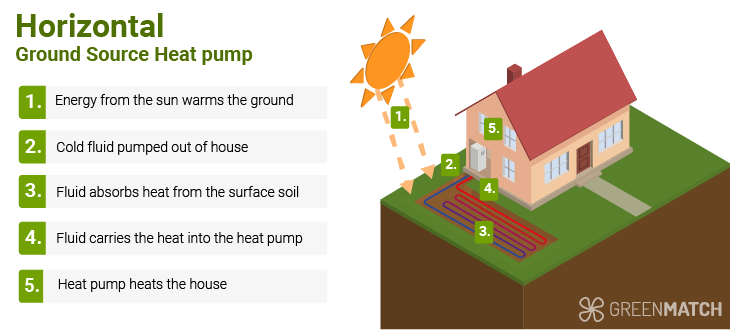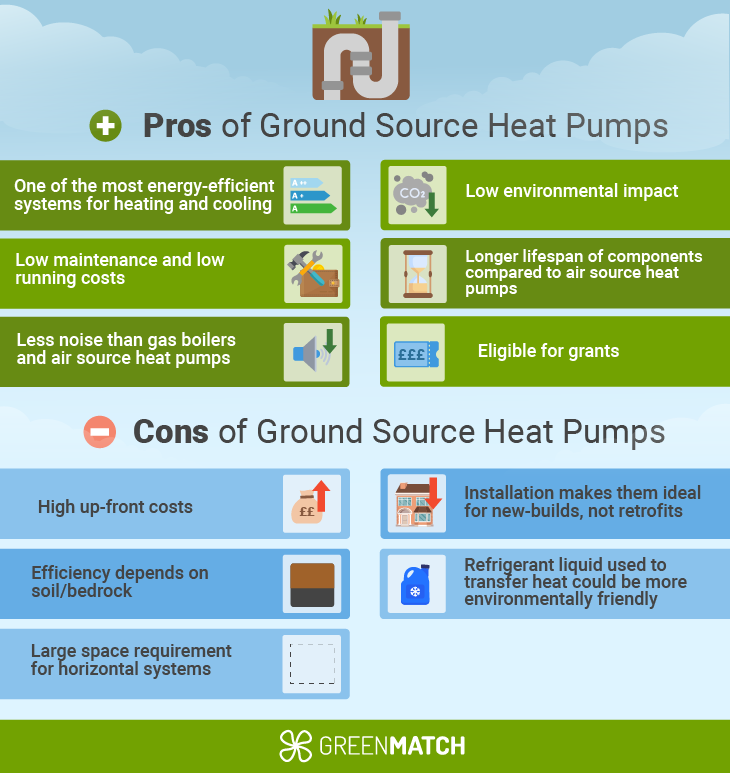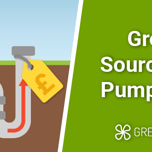
Get up to 4 quotes by filling in only 1 quick form

Slash your energy bills by installing a heat pump

We’ve helped over 500,000 homeowners reduce their carbon footprint
- GreenMatch
- Ground Source Heat Pumps
Ground Source Heat Pumps: A Complete Guide

Heat pumps are devices that with a small amount of electricity are capable of transferring heat from the air, water or ground in order to meet your home’s heating or hot water demands. These energy systems are a sustainable solution that helps lower annual energy bills while bringing us a step closer to achieving the UK’s ambitious Net Zero Target by 2050.
Therefore, heat pumps are a better, low-carbon alternative to heating homes compared to gas boilers. They’re expected to only become more favourable for homeowners in the foreseeable future with the recent introduction of the Heat and Buildings Strategy and the UK Government’s slashing of VAT on energy efficiency measures to 0%.
There are three types of heat pumps: air, water and ground source heat pumps. As their name indicates, ground source heat pumps transfer heat from the ground. In this article, we have prepared a complete guide on everything there is to know about ground source heat pumps, their costs of purchasing and running, types and much more.
To learn more about how a ground source heat pump might suit your home’s unique specifications, it’s best to consult a professional heating engineer who can assess your needs and then offer quotes for their installation services. Finding installers you can trust, who will offer fair and accurate quotes, can take considerable time and effort.
To truly locate the best deals for new heat pump installations, like a ground source or air source heat pump installation, you will need to call multiple installers, ensure they’re properly certified, explain your heating situation, and ask for quotes. GreenMatch can save you this extra time and money by allowing you to compare quotes directly from licensed installers from our network, all of them vetted by us.
All you have to do is fill in some details using our quick and easy form and within 48 hours, you’ll hear from up to 3 local heat pump installers.
- Quotes from local engineers
- Payment by finance available
- Save up to £1100 per year
It only takes 30 seconds



- Ground Source Heat Pumps: A Complete Guide
- Is a ground source heat pump the right investment?
- What is a ground source heat pump?
- Types of ground source heat pumps
- Ground source heat pump efficiency
- Installation of ground source heat pumps
- Price of ground source heat pumps
- Advantages and disadvantages of GSHPs
- Underfloor heating system vs. radiators
- Does the government provide grants for GSHPs?
- Frequently asked questions
Is a ground source heat pump the right investment?
Ground source heat pumps are an effective and environmentally-friendly investment. So a heat pump for a boiler switch can help the average UK household save up to £670 on heating bills annually when compared to conventional, gas-fired heating systems. Initial investments are high, but ground source heat pump prices vary depending on the project and the household specifications.
A few of the many benefits of ground source heat pumps include:
- Save up to £1,600 a year on your heating bill when replacing an old electric system.
- Get the most out of your heat pump with its long product lifespan. Inside components last approximately 25 years, while the estimation for the ground loop system exceeds 50 years (sometimes reaching up to 80 years).
- Equal distribution of heat throughout your home.
- Constant performance throughout the year.
While a ground source heat pump can significantly improve the energy efficiency of your heating system, the upfront installation costs make it unfeasible for many.
In this case, you may want to consider a hybrid heat pump. This combines a ground source heat pump with another heating system, typically a gas or oil boiler which works alongside your ground source heat pump. This means you could install a smaller ground source heat pump which will cost less overall.
What is a ground source heat pump?
The purpose of a ground source heat pump is to absorb heat from one place and transport and release it to another location, in this case, your home. Just like other heat pumps, it can be used for both space heating (such as radiators or underfloor heating), as well as domestic water heating. It is also similar to a geothermal pump.
A ground source heat pump is able to work since the earth absorbs energy released from the sun. This means that underground temperatures remain stable all year round. In the UK, the ground temperature (a few metres below our feet) is constantly around 8-11°C. This results in heat being extracted from the ground to heat your home.
We’ve listed the main components of a ground source heat pump:
- Heat pump unit
- Underground heat exchanger
- Pipes (e.g. ground loops)
- The distribution system (e.g. radiators, underfloor heating, hot water)
The underground heat exchanger is installed underground and is connected to the heat pump unit via a piping network. The piping system can be configured differently depending on the amount of land available and the geological conditions.
Then a mixture of water and antifreeze is pumped into the ground via the heat pump, and the antifreeze mixture is continuously warmed up by the constant temperature of the ground.
The liquid is fed into a heat exchanger and energy absorbed from the ground is transferred to a refrigerant, which boils at a low temperature until it turns into a gas.
The gas is fed into a compressor and the compressing process makes the temperature of the gas rise.
This is then fed to a condenser, where it is distributed to the wet central heating system of the house, such as radiators, showers, faucets, and underfloor heating.
If you’d like more information on how a ground source heat pump works, you can watch the video below.

Types of ground source heat pumps
One way some of the best ground source heat pumps are distinguished is by the type of loop system they use. There are two different types of loops systems:
- The open loop system extracts clean groundwater to directly pass through a heat pump where heat is extracted.
- The closed loop system draws the heat from the ground itself and uses a continuous loop of piping connected to the indoor heat pump.
Each looping system has its own advantages and disadvantages. While an open loop system is cheaper to install, they require availability to groundwater. Whereas, closed loop systems tend to be more reliable, require less maintenance, and are extremely efficient due to extracting heat from the earth. In this section, we’ll focus exclusively on the types of closed loop systems.
Closed loop vertical ground source heat pump
This closed loop ground source heat pump uses a borehole that can vary in cost to install. Vertical boreholes are a more expensive alternative when there is not enough area to lay the pipes horizontally. It is more often the appropriate choice for suburban homes where space is restricted. A hole is dug at least 6m into the ground for insulation and the total piping will be 50-150m deep depending on the composition of the ground and the heat requirement of your home.

Closed loop horizontal ground source heat pump
This ground source heat pump system is laid in horizontal trenches that are approximately 1-2 metres deep. It is more common in rural areas where there is more land available. To install the horizontal system, the area required depends on the heating and cooling loads of your home, the depth at which your loop is going to be buried, your soil and its moisture, the climate, and the efficiency of the heat pump. The average 150 m2 home needs an area of between 300 and 700 m2.

Closed loop system for pond/lake
Although less common than horizontal or vertical systems, a closed pond loop is also an option. It is uncommon because it requires proximity to a body of water, so an open loop system is usually preferable as it takes from groundwater instead. However, a closed loop system may be advantageous when poor water quality prevents the use of an open loop.
Other types of closed loop systems
There are two other system types to consider when choosing the right ground source heat pumps:
- Direct expansion (DX)
This system relies on a cyclical process when the refrigerant changes its position back and forth between a gas and a liquid. When the refrigerator absorbs the heat, the compressors start pulling the vapour from suction lines and the process is launched. - Indirect expansion
This system is commonly used in freezer applications with carbon dioxide when changing secondary working media. In other words, during antifreeze solution/water circulation the energy is relocated from or to the refrigerant circuit through ground heat exchange pipework.
Finding which type of ground source heat pump is right for you is one of the first steps towards unlocking incredible energy savings for your home. Start by obtaining an Energy Performance Certificate (EPC) to accurately assess if your home’s energy efficiency is right for a ground source heat pump. Armed with this knowledge and an EPC in hand, you can get personalised quotes for ground source heat pumps that are tailored to your home’s specific needs.
In fact, with GreenMatch, you can get up to 3 quotes without any of the hassles of researching! Why 3? Multiple quotes allow you to compare them to find the best deal. This way you know you’re only accepting the best deal possible and not being overcharged.
Start getting quotes today by clicking the button below.
- Quotes from local engineers
- Payment by finance available
- Save up to £1100 per year
It only takes 30 seconds



Ground source heat pump efficiency
Ground source heat pumps have, on average, an efficiency of 300% to 400%. That means for every kilowatt (kW) of electricity consumed by the heat pump, around 3-4 kilowatts of heat is generated in return. A GSHP has, on average, a coefficient of performance (COP) of 3.5 to 4.5.
GSHP systems save energy by using the constant temperature of the ground to increase the seasonal efficiency of home heating. The source of heat used for ground source heat pumps is the sun, as it heats the groundwater resulting in the stable temperature of the Earth’s floor.
The type of soil also affects ground source heat pump efficiency. The thermal properties of soil in the UK vary a lot by region, therefore, to get an accurate estimation of efficiency, it’s important to get your specific property assessed by a professional.
Are heat pumps efficient in cold weather?
The heat pump’s external pipelines are inserted in the soil which keeps its temperature below 1 metre relatively stable all year round. For this reason, cold weather is not likely to affect your heat pump’s efficiency significantly, and even less so if you have a vertical GSHP.
What do the COP and SCOP tell us about efficiency?
Ground pump systems reach rather high-performance coefficients, with an average between 3 and 4. The coefficient of performance (COP) is found by dividing the useful heat output by the electrical energy input.A ground source heat pump that transfers 4 kilowatts of heat from the ground for 1 kilowatt of electricity has a COP of 4. While the COP is the performance delivered at a specific moment, the SCOP will provide an average for the whole year. We recommend you check out the seasonal coefficient of performance (SCOP), as it is a more accurate representation of the efficiency during different times of the year, compared to the COP.
Installation of ground source heat pumps (3 basic questions)
House size and building requirements will determine whether a vertical or horizontal loop system is needed. The first step is the excavation of the loop fields.
To install a vertical ground source heat pump, the loop is placed in the drilled well that is dug deep from 50m to 150m in the ground. The heat exchanger is then installed in order to capture the heat from the ground.
For horizontal installation, a large area of land is dug up so that the loops can be placed on the land without having to dig deep into the earth.
How much space is required for a ground source heat pump?
Horizontal GSHPs require a large amount of space. Depending on the size of the heat pump, you may need 2 or more ground loops. For the average home’s system, you can expect to need between 600m2 to 1200m2 of clear land. It’s good to note that for most horizontal collector arrays, you’d also need trenches at least 100m long.
To save space, some decide to lay the pipes in many circular loops (figuratively called ‘slinkies’). However, slinkies do somewhat reduce your ground source heat pump efficiency.
Vertical systems do not require as much surface area, as boreholes are dug vertically into the ground. The depth and number of boreholes depend on the system size and the type of soil. Typically, an 8kW ground source heat pump system would require approximately three boreholes with a depth between 70m to 120m.
How long does it take to install a ground source heat pump?
Once planning, preparation, and getting the necessary permissions are done, the groundwork and laying of the entire ground source heating system can take up to a week. While the heat pump unit itself can be installed within a day, the piping in the ground and digging the boreholes can be more complex, taking usually 1-2 days depending on geological conditions. Finally, the heat pump device itself needs to be installed and connected to your heat distribution infrastructure.
Do you need planning permission for a ground source heat pump?
For most cases, you won’t need special planning permission to install a ground source heat pump, as it’s considered a permitted development. However, it is important to note that special planning permissions are required in Wales and Northern Ireland. In England and Scotland, permissions depend on your location and the size of your property.
You would also need planning permission if you’re installing more than one ground source heat pump, live in a listed building or a conservation area. Nonetheless, a local heat pump installer would be familiar with the regulations of your area and can help tailor advice to your home.
We’ve made a video about the 5 questions you should ask any heat pump installer before going forward with the installation. This way you’ll know you’re making the right choice for your home.

Price of ground source heat pumps
Some of the best ground source heat pumps can cost between £16,000 and £35,000 to install in your home. We’ve provided a wide cost range as the price of a ground source heat pump depends on several factors that change depending on your home:
- Type and size of ground source heat pump
- Installation complexity
- Labour cost
The upfront costs of ground source heat pumps are higher than other systems, but the difference is usually compensated by energy savings, higher efficiency and the available heat pump grants that help with the costs. Your running cost will depend on the size of your home and how well-insulated it is.
When you are trying to figure out how much a ground source heat pump costs, you need to bear in mind that this also depends on whether any new radiators or a fully new underfloor heating system is required, therefore the price estimations below don’t include any wet system upgrade.
As you can see, the specific cost of a ground source heat pump will vary from house to house. While there are a multitude of important factors that contribute to the price, they ultimately ensure that you’re getting the right heat pump for your home and that it runs efficiently for years to come. That’s why we cannot stress enough how important a qualified local heating installer is.
Contacting multiple qualified heating installers comes with two main benefits. The first is that local installers know the local regulations and the best suppliers in the area. That means they can offer more competitive pricing for your area. The second benefit of contacting multiple installers is that you can compare quotes from each of them to choose the best deal. That way you know you’re not being overcharged and you’re paying the best price.
GreenMatch has built a large network of qualified heat pump installers across the country guaranteeing that there’s a local installer in your area. You can get competitive quotes from up to 3 of these installers within 48 hours by clicking the button below and answering a few questions. It’s that easy!
- Quotes from local engineers
- Payment by finance available
- Save up to £1100 per year
It only takes 30 seconds



Groundwork costs of vertical vs. horizontal systems
There is a significant difference in groundwork costs between horizontal and vertical systems. Although the horizontal installation is cheaper it requires, on average, anywhere between 600m2 to 1200m2 of clear land.
| Number of Rooms | Heat Pump and Installation Cost | Horizontal Groundwork Cost | Vertical Groundwork Cost |
|---|---|---|---|
| 2 | £16,000 | £3,000 | £6,000 |
| 4 | £21,000 | £5,000 | £13,000 |
| 6 | £32,000 | £8,000 | £20,000 |
| 7+ | £42,000 | £12,000 | £30,000 |
The costs depend on each individual case and numbers do not represent actual offers. They are merely for general reference.
How much money can you save with a ground source heat pump?
The following is a table based on figures from the Energy Saving Trust, outlining the carbon dioxide and energy bill savings when using a ground source heat pump in England, Scotland and Wales, under the current energy price guarantee. The existing systems listed are all non-condensing systems, which are likely the systems users are looking to replace.
| Current System | Savings on Energy Bill (£/year) | Carbon Dioxide Savings (kg CO2/year) |
|---|---|---|
| Gas | £195 – £670 | 2,800 – 1,900kg |
| Electric | £950 – £1,600 | 1,500 – 2,100kg |
| Oil | £375 | 2,900 – 4,400kg |
| LPG | £305 – £860 | 2,200 – 3,300kg |
| Coal | £800 | 7,000kg |
What brands sell ground source heat pumps?
Ground source heat pumps differ in efficiency and price depending on the brand. Certain ground source heat pump manufacturers may have similar efficiencies and prices, yet some manufacturers offer them at higher costs than others.
There are many brands of ground source heat pumps available in the UK market, some of the most known brands include Vaillant, Viessmann, Nibe, Kensa, and Worcester-Bosch. Due to the large variety of brands available, it is important to compare supplier quotes and ground source heat pump reviews to help make your decision easier while choosing the most competitive price.
Luckily for you, GreenMatch has built a network high-quality and highly-rated heat pump installers across the country. So rather than spending hours researching each brand individually, you can get quotes from installers within 48 hours who will recommend the top heat pump brands tailored to your needs.
It’s as simple as filling in the form and waiting to be contacted by our network of trusted installers who will provide you with up to 3 tailored quotes, ensuring you receive the hassle-free and expert-driven service you deserve. Don’t miss out on this opportunity to enjoy the cost saving benefits of a ground source heat pump in your home.
Click the button below to start getting quotes today.
- Quotes from local engineers
- Payment by finance available
- Save up to £1100 per year
It only takes 30 seconds



Advantages and disadvantages of ground source heat pumps
Ground source heat pumps are a promising technology that can help reduce our reliance on fossil fuels, lower our carbon footprint and offer us many other heat pump advantages. But before you install one in your home or business, it’s important to understand both the advantages and disadvantages of ground source heat pumps.
In this section, we’ll list the pros and cons of ground source heat pumps so you can make an informed decision.
- One of the most energy-efficient systems for heating and cooling
- Low maintenance and low running costs
- Less noise than gas boilers and air source heat pumps
- Low environmental impact
- Longer lifespan of components compared to air source heat pumps
- Eligible for grants
- High up-front costs
- Efficiency depends on soil/bedrock
- Large space requirement for horizontal systems
- Installation makes them more ideal for new-builds, not retrofits
- Refrigerant liquid used to transfer heat could be more environmentally friendly

Underfloor heating system vs. radiators
Ground source heat pumps and radiant floor heating work very well together—this is actually the way to get the maximum out of your heat pump.
An underfloor heating system performs better than radiators because the heat is transferred equally across the whole surface, whereas radiators need to spread the heat from one corner to the entire room.
However, due to the higher cost of underfloor heating, radiators are also a good choice that results in high performance. The SCOP is higher for underfloor heating compared to radiators because heat distribution is well designed with underfloor heating and therefore the floor system will likely have a lower output temperature than a radiator, meaning a higher coefficient of performance.
Does the government provide grants for ground source heat pumps?
Yes, there are several heat pump grants you may be eligible for to get a ground source heat pump. A grant can help you cover the upfront costs of buying and installing a low-carbon heating system. In this section, we’ll cover all of the grants for ground source heat pumps.
In place of the Renewable Heating Incentive (RHI), which stopped accepting applicants in March 2022, the government introduced the Boiler Upgrade Scheme the following April. This £450 million initiative comes as part of the Heat and Buildings Strategy and now offers £7,500 off the supply and installation of a ground source heat pump to homeowners in England and Wales.
You might have also heard of the Energy Company Obligation 4 scheme (ECO4) which, if eligible, could cover up to 100% of the costs of switching to a renewable heating system, like a ground source heat pump. When you apply to the scheme you’ll be told the grant amount you’ll receive depending on your home’s energy performance certificate, income and location.
If you live in Scotland you might be interested in the Home Energy Scotland Loan in which you could get up to £17,500 interest-free loan to install sustainable measures.
Finally, all homes that install an energy-saving material reduction in VAT on your ground source heat pump. If you are over 60 years old or receive income or disability benefits, you could receive a 5% tax reduction. Depending on the costs, you can either get a discount on the whole product or only on the installation.
Finding fair and accurate heat pump installation quotes takes careful planning and research. You could risk overpaying for supply and installation from a company that operates nationwide. Instead, why not let GreenMatch take the hassle out of sourcing quotes by directly connecting you with up to 3 licensed installers, local to your area.
Fill in our quick easy form, and our team will find the best heat pump installers for your home’s unique specifications. In 48 hours, you will hear from up to 3 locally based installers, avoiding hours of searching for, and researching installers yourself.
Comparing multiple local quotes guarantees the best deal since local installers will charge less for the supply and delivery, amounting to less overall installation costs. What’s more, with multiple quotes, you can objectively compare to locate the best deal. Just click the button below to get started.
- Quotes from local engineers
- Payment by finance available
- Save up to £1100 per year
It only takes 30 seconds



Frequently asked questions

Aris Vourvoulias is the Head of Content in GreenMatch. Aris is a passionate author and marketer with an educational background in journalism. He continuously writes, reviews, and educates himself in the areas of business, finance, and renewable energy. He has managerial experience in many European markets, including UK, Denmark, Sweden, and Finland. He and his content team have been featured on reputable sites like GreenPeace, Guardian, iNews, Gizmodo, and more
 We strive to connect our customers with the right product and supplier. Would you like to be part of GreenMatch?
We strive to connect our customers with the right product and supplier. Would you like to be part of GreenMatch? - Ground Source Heat Pumps: A Complete Guide
- Is a ground source heat pump the right investment?
- What is a ground source heat pump?
- Types of ground source heat pumps
- Ground source heat pump efficiency
- Installation of ground source heat pumps
- Price of ground source heat pumps
- Advantages and disadvantages of GSHPs
- Underfloor heating system vs. radiators
- Does the government provide grants for GSHPs?
- Frequently asked questions






